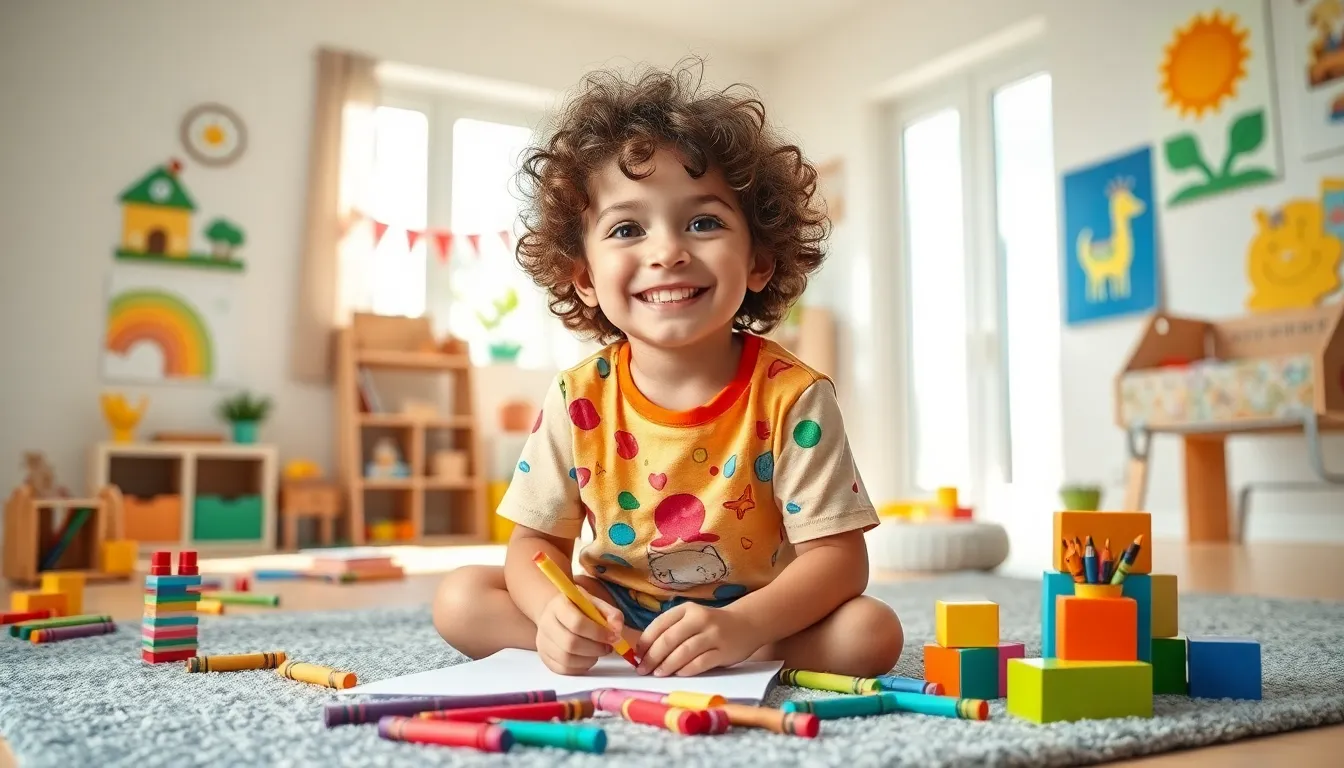Table of Contents
ToggleIn a world where screens often steal the spotlight, nurturing a child’s creativity is more crucial than ever. It’s time to unleash those wild imaginations and transform everyday moments into extraordinary adventures. After all, who wouldn’t want their kid to dream up a spaceship made from cereal boxes or a masterpiece painted with spaghetti?
Enhancing child creativity isn’t just about arts and crafts; it’s about fostering an environment where curiosity thrives. From playful experiments to imaginative storytelling, every activity can spark innovation. So buckle up and get ready to explore strategies that’ll turn your little ones into the next Picasso or Einstein—minus the messy paint splatters, hopefully! With the right approach, creativity can become a superpower that lasts a lifetime.
Understanding Child Creativity
Child creativity encompasses the ability to think outside conventional boundaries. Engaging in imaginative activities encourages exploration and innovation.
Definition of Creativity
Creativity in children refers to generating new ideas and solutions. It involves divergent thinking, which is evaluating multiple options rather than a single solution. Problem-solving and imagination often intermingle in this process. Children express creativity through various outlets like drawing, storytelling, and play. Developing creative skills early fosters flexibility in thought, enabling adaptability in various situations.
Importance of Creativity in Children
Fostering creativity in childhood significantly impacts personal and academic growth. Engaging in creative activities boosts cognitive skills, enhancing critical thinking and problem-solving abilities. Creative children often exhibit higher self-esteem and emotional intelligence. Creativity allows children to express feelings and communicate thoughts. An environment that promotes creativity leads to lifelong benefits, making children more resilient and adaptable adults. Academic success links closely with creative skill development, facilitating innovative thinking throughout life.
Factors Influencing Child Creativity
Many factors significantly influence a child’s creativity. Understanding these elements helps create a conducive environment for imaginative growth.
Environment and Space
A stimulating environment fosters creativity. Open spaces encourage exploration and experimentation. Creative materials like art supplies or building blocks enhance imaginative play. Natural light and color can inspire new ideas. Organized chaos often allows children to feel free, promoting innovative thinking.
Parental Involvement
Active engagement from parents boosts creative development. Parents who ask open-ended questions encourage children’s thought processes. Participating in creative activities together strengthens bonds and nurtures imagination. Showing interest in creative endeavors leads to increased confidence. Supportive feedback helps children explore ideas without fear of failure.
Educational Approaches
Creative educational methods also play a crucial role. Project-based learning encourages children to think critically and innovatively. Integrating arts into the curriculum enhances problem-solving skills. Freestyle exploration during lessons sparks curiosity and engagement. Schools that prioritize creativity help prepare children for future challenges.
Strategies for Enhancing Child Creativity
Parents can implement various strategies to enhance their children’s creativity. Encouraging exploration through engaging activities plays a pivotal role.
Encouraging Open-Ended Play
Open-ended play promotes imagination and creativity. Allowing children to choose their materials fosters decision-making. Providing items like blocks, dolls, and art supplies invites exploration. When children create their own stories or scenarios, they develop unique ideas. Engaging in this type of play for at least 30 minutes daily boosts their creative confidence. Additionally, facilitating outdoor playtime in parks exposes children to different environments. Experiencing nature sparks curiosity and imaginative thoughts.
Supporting Artistic Expression
Supporting artistic expression nurtures a child’s creative abilities. Providing various art materials–paints, markers, and clay–encourages experimentation. Encouraging free drawing or crafting projects promotes individual artistic development. Allowing children to share their creations increases self-esteem and communication skills. Setting aside regular time for artistic endeavors fosters routine and dedication to creativity. Visiting art museums can also inspire new ideas and appreciation for different artistic styles. Art classes and workshops introduce children to new techniques, expanding their skills and interests.
Fostering Problem-Solving Skills
Fostering problem-solving skills enhances creativity and critical thinking. When children face challenges, guiding them to explore possible solutions develops resilience. Encouraging them to ask questions promotes curiosity and independent thinking. Providing puzzles or challenges, such as building structures or solving riddles, engages their minds. Allowing ample time for reflection after problem-solving exercises instills patience. Supporting collaborative problem-solving with peers encourages teamwork and creative discussions. Engaging in projects that require multiple steps teaches planning and execution, reinforcing their learning experience.
Activities to Boost Creativity
Engaging in targeted activities can significantly enhance a child’s creative abilities. Parents can introduce diverse projects that stimulate imagination and promote exploration.
Craft Projects
Craft projects involve using various materials for open-ended creation. Introducing supplies like paper, paint, fabric, and recycled items inspires children to experiment. Children can create unique artworks, custom greeting cards, or imaginative sculptures. Providing guidance allows kids to explore techniques while fostering independence. Group projects further enhance collaboration, helping children share ideas and learn from one another. Such experiences build confidence and expand creative expression, encouraging children to think outside conventional boundaries.
Storytelling and Imagination Games
Storytelling and imagination games unlock a child’s narrative potential. Encouraging children to create their own stories promotes verbal skills and critical thinking. Using prompts or pictures as inspiration can spark imaginative plots and characters. Role-playing different scenarios expands creativity while enhancing social skills. Encouraging kids to act out stories with family or friends adds excitement and builds confidence in performance. Engaging in daily storytelling sessions enriches verbal expression and fosters a lifelong love for literature and creativity, benefiting cognitive development and emotional intelligence.
Nurturing a child’s creativity is essential for their overall development. By providing an environment that encourages exploration and imagination, parents can significantly impact their child’s ability to think critically and solve problems. Engaging in creative activities not only boosts self-esteem but also fosters a lifelong love for learning.
Through open-ended play and collaborative projects, children learn to express themselves and build confidence. As they navigate their creative journeys, they develop skills that will serve them well into adulthood. Prioritizing creativity today ensures that children grow into resilient and innovative individuals ready to tackle future challenges.




